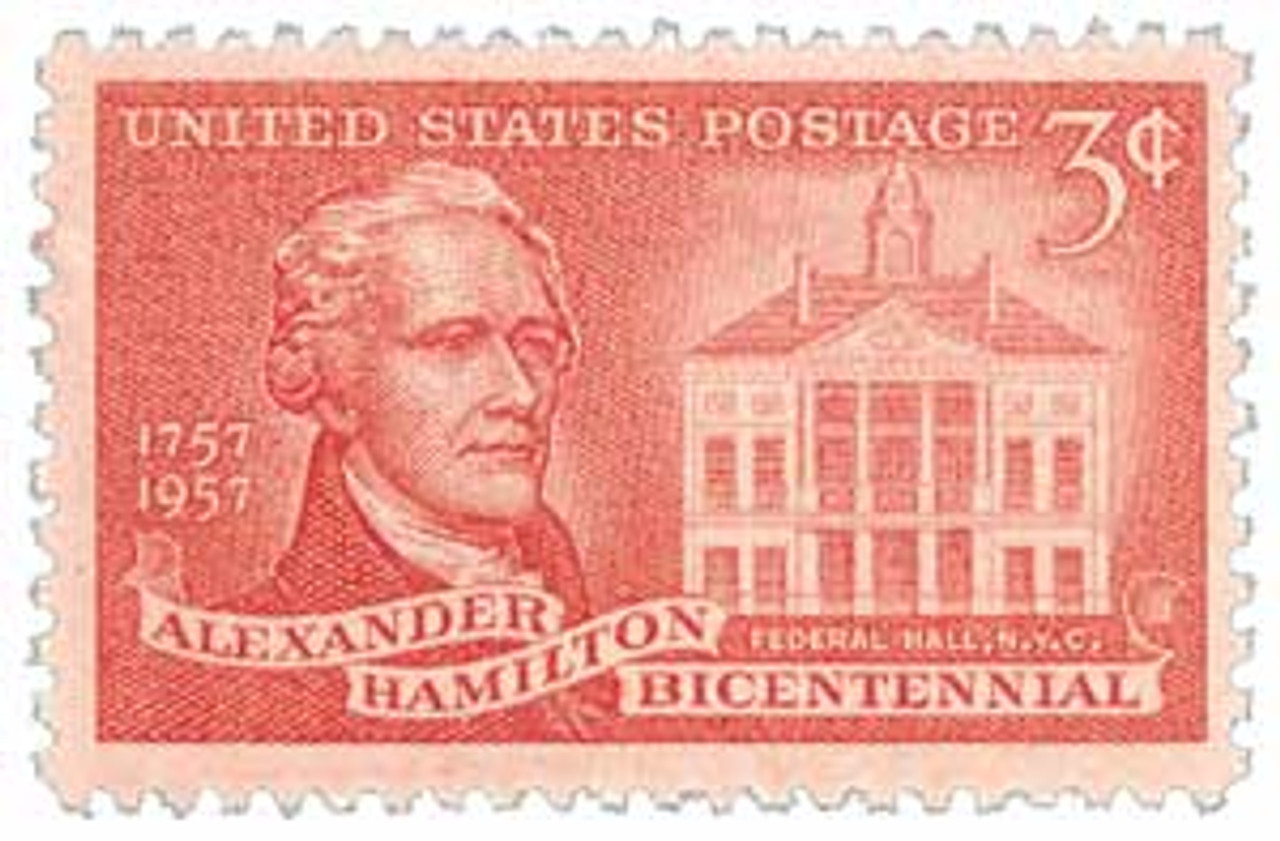
U.S. #1086
1957 3¢ Alexander Hamilton and Federal Hall
Issue Date: January 11, 1957
City: New York, New York
Quantity: 115,299,450
Printed by: Bureau of Engraving and Printing
Printing Method: Rotary Press
Perforations: 11 x 10 ½
Color: &... more
U.S. #1086
1957 3¢ Alexander Hamilton and Federal Hall
Issue Date: January 11, 1957
City: New York, New York
Quantity: 115,299,450
Printed by: Bureau of Engraving and Printing
Printing Method: Rotary Press
Perforations: 11 x 10 ½
Color: Rose red
U.S. #1086 commemorates the 200th anniversary of the birth of Alexander Hamilton, the first U.S. Secretary of the Treasury. Hamilton was one of the key figures in the early days of the United States. He established most of the fiscal policies of the young nation and helped found the U.S. Mint.
Hamilton was an influential player behind the scenes. With the help of John Jay and James Madison, he wrote the “Federalist Papers,” which were a series of 85 published essays supporting the proposed U.S. Constitution. They are still regarded as the primary source for interpretation of the Constitution. Hamilton’s influence extended to the Presidency, where he worked hard to influence the elections of 1796 and 1800, between John Adams and Thomas Jefferson.
The stamp also features an image of Federal Hall, located in New York City. It served as the first U.S. Capitol of the United States, and was where George Washington was sworn in as President. The Hall was also where the Bill of Rights was signed.
When Congress moved to Philadelphia in 1790, Federal Hall once again housed the New York City government. The building was destroyed in 1812, and a replacement building was completed in 1842. That building served as the first U.S. Customs House.
Burr–Hamilton Duel
On July 11, 1804, former U.S. Secretary of the Treasury was mortally wounded in a duel with sitting Vice President Aaron Burr.
Long-time acquaintances during the fight for independence, Hamilton and Burr later became bitter political rivals. When a Burr supporter insulted Hamilton’s honor in 1801, his 19-year-old son Philip challenged the man to a duel. Philip Hamilton died of injuries he suffered during the duel, which was held in Weehawken, NJ. Three years later, Burr killed Alexander Hamilton in a duel in exactly the same location with the same pistol used to kill Hamilton’s son.
Their rivalry stemmed from the 1800 election, when the Federalists lost the presidency and control of Congress. Thomas Jefferson defeated John Adams and received enough electoral votes to tie with Aaron Burr. The tie for first place in the election was to be resolved by the House of Representatives, which was controlled by the Federalists.
In a lengthy debate, Hamilton convinced his colleagues that Jefferson was “by far not so dangerous a man” as Burr. After deadlocking in 35 ballots, the House of Representatives chose Jefferson by a margin of ten to four. Although he served one term as vice president, Burr’s refusal to concede defeat in 1800 caused Jefferson to replace him with New York Governor George Clinton in the 1804 election.
Aware that he was being replaced as Jefferson’s running mate in the 1804 election, Vice-President Aaron Burr announced his candidacy for the governorship of New York State. Hamilton joined the race and campaigned vigorously against him.
The years of animosity came to a head and Burr formally challenged Hamilton to a duel. And Hamilton accepted. Prior to the duel, Hamilton wrote a letter he called Statement on Impending Duel with Aaron Burr, in which he wrote, “I have resolved… if our interview is conducted in the usual manner, and it pleases God to give me the opportunity, to reserve and throw away my first fire, and I have thoughts even of reserving my second fire.”
The duel came on July 11, 1804, in Weehawken, New Jersey. Its unclear who shot first, but true to his word, Hamilton fired his gun into the air, a common act. Burr on the other hand, aimed directly at Hamilton and shot him in the lower abdomen, causing extensive internal injuries.
Hamilton died of his injuries the following day, and Burr was charged with murder. After his acquittal, Burr fled to South Carolina briefly and then west, where he allegedly planned to establish a new territory.









